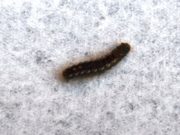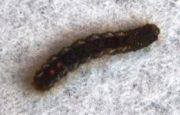According to the Maine Forest Service the browntail moth was accidentally introduced into Somerville, Massachusetts from Europe in 1897. By 1913, the insect had spread to all New England states, New Brunswick and Nova Scotia. Populations of this pest slowly decreased due to natural controls until the 1960s, when browntail moth was limited to Cape Cod and a few islands off the Maine coast in Casco Bay. The moth persists on islands and in coastal southern Maine, extending up river valleys.
The larval stage (caterpillar) feeds on foliage of hardwood trees and shrubs including oak, shadbush, apple, cherry, plum, and rugosa rose. Larval feeding reduces growth and occasionally causes mortality of valued trees and shrubs. However, the primary concern is the impact on humans from contact with poisonous hairs found on the caterpillars. If these hairs come in contact with human skin, they cause a rash similar to poison ivy that can be severe for some people.
April to June (these photos were taken in early June) the moth has lots of its poisonous hairs on display. They continue to be dangerous through July when they build their cocoons. Note the two red spots that confirm the moth’s identity. (Click on the photo at left for an enlarged view.)
Additional resources
Maine Forest Service “Browntail Moth.” http://www.maine.gov/dacf/mfs/forest_health/insects/browntail_moth.htm (accessed June 2, 2018)
Town of Harpswell. “Browntail Moth.” http://www.harpswell.maine.gov/index.asp?SEC=D02D79B8-E997-4C07-915E-FBFD30C1DC58&Type=B_BASIC (accessed June 2, 2018)



